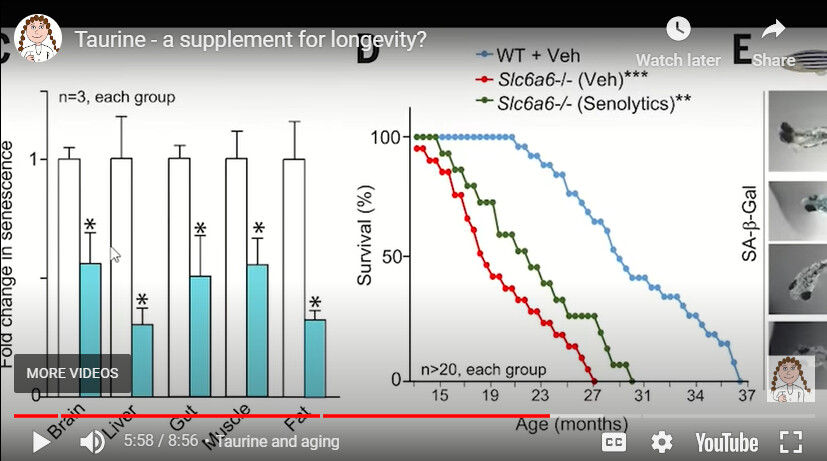As it is known, senolytics are agents that target and eliminate aging cells.
https://www.ncbi.nlm.nih.gov/pmc/articles/PMC9924942/
Years ago my doc told me to take daily NAC and quercetin and having been doing so… and no, I have no idea why, but just do as I’m told :). I’ll be curious to learn here if I should continue !!!
I don’t think D+ Q increase lifespan
I read somewhere that rapamycin lowers senescence
If you are interested in senolytics, you MUST watch the video in the link below.
What swayed me was the study where they measured senescence in 3 groups:
Control, D+Q and Taurine (see chart below)
The senescent cell load in the control group was normal as you would expect. (red line)
The D+Q group. (green line)
The Taurine group. (blue line)
The moral of the story is just take taurine (and Rapamycin) to reduce senescent cells.
The video here:
@DeStrider This is interesting. I continue to wrestle with taurine. Does Matt Kaeberlein take taurine? I’ll take if he does.
At 18:44 Matt Kaeberlein talks about Taurine. He says it’s very compelling and it’s in the second tier below Rapamycin.
@DeStrider thanks! But does he take it? I have been thinking very hard about why these longevity researchers are so conservative with regard to supplements. I’ll wait until Matt K takes it.
Maybe Taurine + D&Q be better to decrease senecent cel than Taurine alone? Who knows? The study above dont consider that…
Took D&Q once. Mad me sick as a dog. Don’t see compelling evidence to support using it.
Isn’t the drawback here that the mice were given taurine from birth? Many of us in this group may have started taking taurine at a more advanced age when senescent cells are already present?
Your body clears senescent cells well until you are in mid life. In fact, senolytics probably aren’t useful until you get into your mid-50s.
Also, your body produces enough Taurine until your mid-40s. You only need to supplement starting around that age.
That was my point exactly. There are quite a few people here I suspect in the latter group, myself included.
It would be interesting to see what the senescent cells load is for people taking Rapamycin or Taurine and compare that to a normal person and someone taking D+Q.
Does anyone here measure their senescent cells that could share some data?
how do you measure that?
Most senescent cells are located in your adipose tissue (fat). I guess you’d take a fat sample and analyze it?
Anyone planning on having a liposuction treatment soon? ![]()
One of the best-characterized and simplified methods to measure senescence in vitro and in vivo is the β-galactosidase (β-Gal) assay , which measures β-Gal activity expressed by senescent cells that can be detectable at pH 6.0 by immunohistochemistry.
Rapamycin is thought to be a senomorphic - meaning it prevents cells from getting into the senescent phase, There is no data to show that it is a senolytic, I have been dosing with D+Q for the last 2 years (maybe more) at 100 mg D + 1.5 g Q, three days in a row for three weeks every 4-5 months and I have seen no noticeable effect.
I take Rapa at 6 mg. every Sunday, Dasatnib (100mg.) + Quercetin (1200mg) for two consecutive days every other month, and 3gm of Taurine daily. I started with Rapa and Senolytics 3 years ago because of problematic osteoarthriitis limiting physical activity and other symptoms of chronic inflammation. Two years later my knees were 100% again (at age 63) and distance trail running in the hills again with my dog. In the past year, I added GlyNAC (3gm and 2gm daily) and Taurine (3 gm daily), but that was after two years with Rapa and senolytics only. My most recent blood test came through with a CRP less than one, my gum pockets (recent dental exam) are about one third the depth they used to be (common measure of systemic inflammation), and I have zero osteoarthritis when three years ago it was deblitating. My N=1 is the senolytics plus Rapa were a game-changer that gave me my life back (as measured by tangible pain and inflammation levels). Taurine and GlyNAC were only added after the dramatic changes in health form the first two years with Rapa and senolytics. All other supplements are just the common basics like fish oil, vitamin d, magnesium, etc., and would not have produced the effects as described above.
@Todd Welcome to the forum and thank you for your N=1 experience! It does coincide with the results of many others who are doing similar treatments. It’s always great to add one more anecdote to the list!
A nice reading about targeting senescent cells with a lot of pictures and explanation.
Maybe mentioned before on the forum.
My boyfriend has a knee injury after increasing his jogging intensity. He also has an orthopedic imbalance, so he should quit jogging all together. The knee pain developed around last year, when he started walking long distances and dieting for weight loss. After the weight was gone, the pain also resolved, until starting a vigorous jogging routine. I now want to help him heal and get the knee back to normal.
How do you know what exactly caused your improvements? Was it the rapamycin, the senolytics or the combination of both? I’m against the senolytics for my boyfriend, bc of the risks and the lack of data. For myself, I would take more risk, but for loved ones I’ll stay on the safe side.
He’ll be 28 soon, but has that orthopedic imbalance, what could cause his cartilage to decay more quickly. I think at this age, senolytics are not the way to go.

